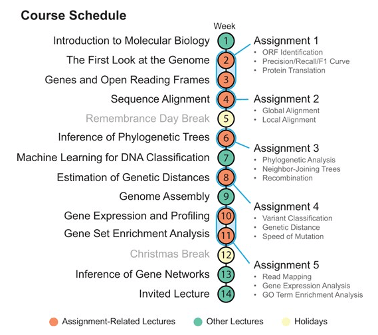Not known Facts About Bioinformatics Tutor
Not known Facts About Bioinformatics Tutor
Blog Article
How Bioinformatics Tutor can Save You Time, Stress, and Money.
Table of ContentsBioinformatics Tutor - TruthsSome Known Factual Statements About Bioinformatics Tutor The smart Trick of Bioinformatics Tutor That Nobody is DiscussingThe Buzz on Bioinformatics Tutor9 Easy Facts About Bioinformatics Tutor Described
Of the overall participants associated with the training, 80% were trainees from public greater education and learning organizations, while the staying 20% came from personal organizations. To qualify for a certification of engagement, trainees were called for to go to at the very least 90% of the total training hours. As an outcome of this need, an outstanding 95% of the individuals efficiently acquired their certifications, having not just fulfilled the minimum participation criteria yet likewise completed all assigned tasks throughout the training.
Throughout the height of the COVID-19 pandemic, especially between June and August 2020, the task team was charged with arranging specialized training in bioinformatics. This training was particularly targeted at students from the research study team Center for Study in Applied Computing at the Federal College of Pará (UFRA) The adjustment to remote knowing systems due to the pandemic developed an opportunity to check out brand-new training methods and electronic tools that improved both reach and performance.
This course was made to supply an available yet comprehensive overview of Artificial Knowledge methods, especially as used in bioinformatics (Bioinformatics Tutor). This virtual layout made it possible for participation from pupils across Brazil, several of whom might not have had the opportunity to go to in-person sessions.
The 2-Minute Rule for Bioinformatics Tutor
A notable function of this training course was its emphasis on hands-on discovering. About 50% of the overall training hours were devoted to sensible activities where trainees constructed smart versions and applications in a variety of scientific domains, consisting of genetics, molecular biology, and environmental information evaluation. Extensively used frameworks and tools such as Spyder, Google Colab, Jupyter Notebooks, and Orange were incorporated right into the coursework. These platforms enabled trainees to involve in real-time information adjustment, model training, and algorithm testing.
The training course attracted 80 participants in total. Sixty of them were affiliated with various college institutions in the state of Pará, while the remaining twenty came from establishments situated in 5 various other Brazilian states. This wide geographical depiction highlighted the national interest in bioinformatics and the expanding need for specialized abilities in this field. By introducing Artificial Intelligence in a practical and pertinent context, the effort served to connect the space between theory and real-world application, supplying pupils with a solid structure for future research or work in the field.
The training effort formed component of a broader scholastic outreach initiative referred to as the Bioinformatics on the Road job. This task has, throughout the years, introduced lots of students to the globe of bioinformatics and computational biology. The events held under this umbrella campaign have happened throughout numerous regions and years, as summed up in Table 1 (List of events, areas, years, and complete numbers of trainees and instructors)
Numerous of these groups, initially brought with each other by their participation in training events, have actually given that gone on to produce independent scientific research in collaboration with local academic establishments. The training not just cultivated clinical thinking within the context of bioinformatics however additionally sparked collaborative connections that prolonged beyond the training setting.
The Facts About Bioinformatics Tutor Revealed
The same team, omitting IH and RR, also acted as tutors for the practical training components. Funding for the project was provided through the grant 88887.200562/ 2018-00 from CAPES.
The Federal University of Pará's Office of Study (PROPESP/UFPA) additionally supplied financial support, especially for the production of the final manuscript. The authors proclaim no business or economic problems of rate of interest that might have influenced the research. All opinions and analyses revealed in this post are only those of the writers and do not necessarily reflect those of their particular institutions, the publisher, editors, or reviewers entailed in the magazine procedure.

9 Simple Techniques For Bioinformatics Tutor
From an instructional perspective, the training approach look at here utilized in the training was intentionally interactive. Classes were carried out in a fashion that encouraged pupil engagement and discussion, exceeding rote memorization to check out just how ideas are created, used in daily life, and examined in scholastic settings. The instructional viewpoint concentrated on supporting both solid and battling pupils, providing customized support, and structure confidence with continual mentorship and perseverance.

Each team, containing about 36 individuals, was sustained by 3 advisors-- the majority of whom were postdoctoral scientists with customized proficiency. These coaches not only assisted develop the team tasks yet additionally promoted their implementation, making sure that each study question was both pertinent and properly difficult. The objective was to give a biologically reasonable context that individuals might look at this now explore through open-ended purposes and accessibility to curated datasets.
For additional understandings into the method and end results of this project-based learning approach, visitors are directed to S1 Text, that includes detailed descriptions of the pedagogical structure, examination approaches, and job themes used in the training sessions.
Not known Incorrect Statements About Bioinformatics Tutor
Of the total participants entailed in the training, 80% were students from public higher education and learning institutions, while the remaining 20% came from exclusive establishments. To certify for a certification of engagement, pupils were required to attend at least 90% of the overall training hours. Notably, past the students who signed up in the training sessions, seven seasoned trainers got involved in delivering the courses, while 3 devoted research teachers worked with the total training process. About 50% of the complete training hours were committed to useful tasks where students constructed intelligent versions and applications in a range of clinical domain names, consisting of genes, molecular biology, and ecological information evaluation. The training not just cultivated scientific read the article reasoning within the context of bioinformatics yet also triggered collaborative connections that extended past the training environment.
Report this page